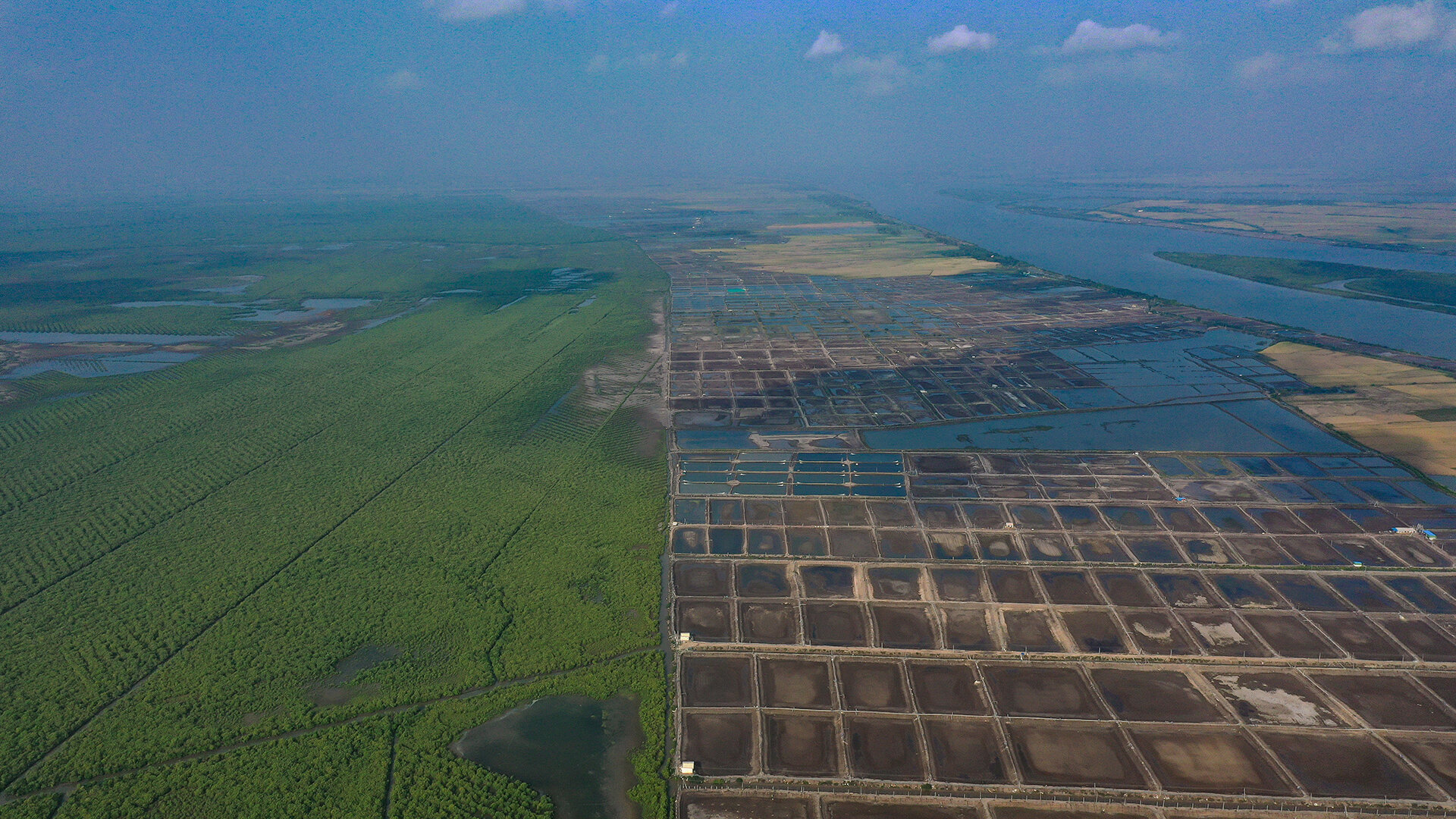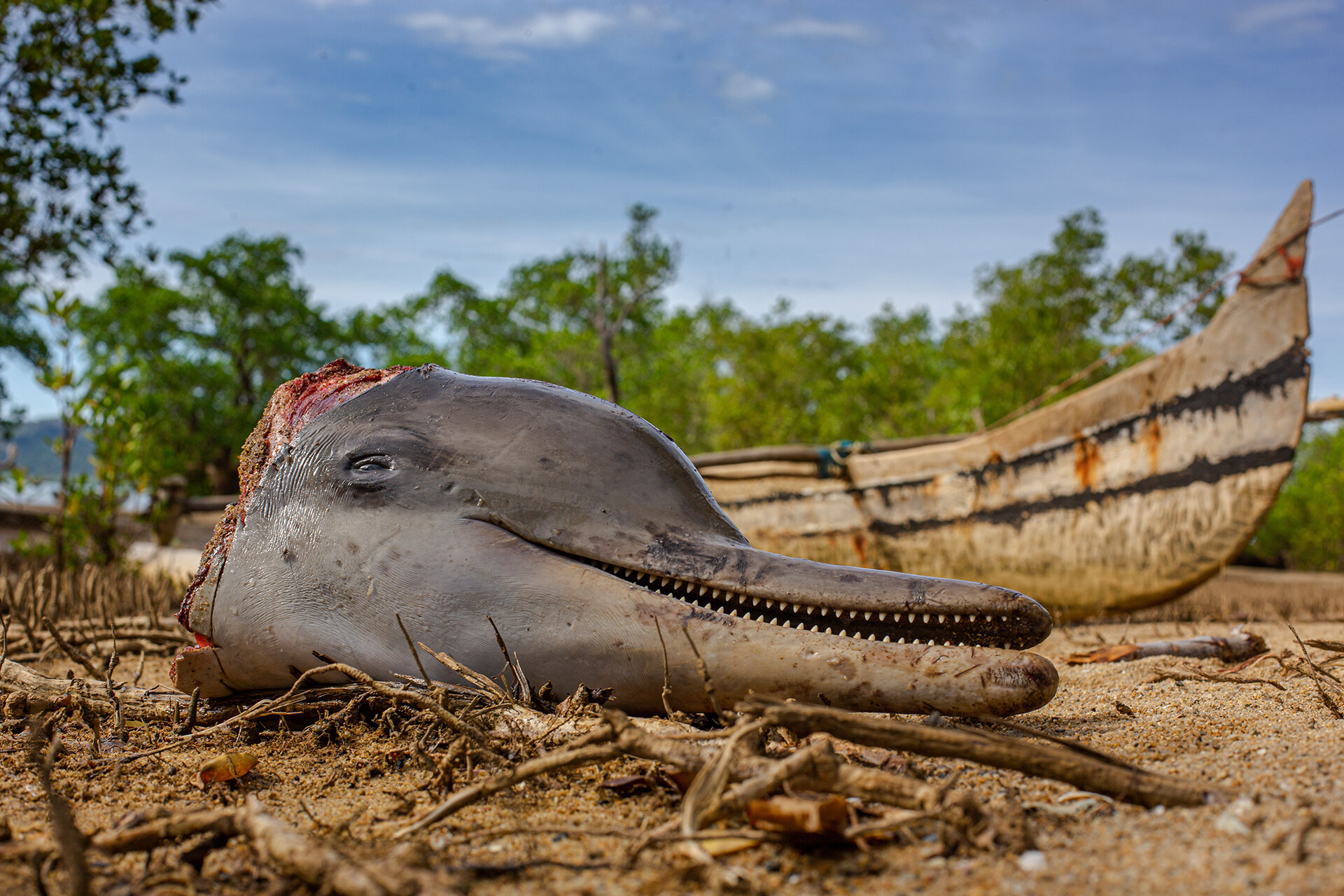Threats to Mangroves: The Mangrove Action Project
Josh Pysanczyn
Mangrove Action Project (MAP) utilises a bottom-up tactic to mangrove conservation and restoration through the implementation of their ‘Community-Based Ecological Mangrove Restoration (CBEMR) technique. Through this holistic approach, their aims are to empower local stakeholders and communities, teaching them how to use mangrove ecology and biology to facilitate the natural regeneration of the forest.
Using photographs from the Mangrove Photography Awards 2020, our aim is to introduce some of the various threats that mangrove forests face, highlighting their sensitivity and vulnerability to anthropogenic stressors, urban encroachment and environmental destruction.
Mangrove Maze. Photo: Janos Leo G. Andanar
Shrimp Farming
Fisheries and aquaculture are an important contributor to food security, livelihoods and global food security, especially in low income and developing countries. In communities inhabiting the coastal regions of the tropics, mangrove shrimp farming, originally hailed as part of the ‘blue revolution’, represents an intensive single-species aquaculture which, when practiced unsustainably, poses one of the biggest threats to the ecosystem.
Mangroves and Shrimp farms in India. Photo: Srikanth Mannepuri
Intensive, single-species aquacultures (or monocultures) reduce biodiversity in a system in return for a more ‘controlled’ environment. A study investigating shrimp farming in Thailand suggest that this ‘control’ is usually achieved by removing the reliance on the original ecosystem services and increasing external inputs. The resulting industry trades long-term benefits provided by the ecosystem for short-term economic benefits, which often accompany long-term environmental and social degradation.
Tiger shrimp (Penaeus monodon) at a seafood market in Thailand. Photo: Pixabay.
Thailand is the biggest producer and exporter of shrimp, exporting 90% of its production. Due to the ideal conditions offered by mangroves, such as brackish water, abundant fry, cheap land and a low-lying area, mangrove forests provided a convenient and easily exploitable setting for shrimp aquaculture. As such, between 1961 and 1993, Thailand’s mangrove area halved from 364,000 ha to just 168,700 ha.
Destroyed Mangrove Habitat. Photo: Shane Gross
The destruction of mangrove forests for the creation of shrimp ponds has severe consequences on the ability of mangroves to provide habitat and sanctuary to wildlife, and threatens their provision of fundamental ecosystem services.
For instance, the construction of shrimp ponds interferes with the hydrology of the forest leading to coastal erosion, saltwater intrusion, increased fertiliser run-off and overall habitat loss. This, in accompaniment with the treatment of antibiotics, large quantities of organic waste, and the use of wild fish for shrimp feed, has led to a severe deterioration of wild fish stock, threatening biodiversity and the long-term livelihood of mangrove communities. Furthermore, without their ecological fortress, coastal communities are at increased risk from tidal waves and cyclones.
However, the restoration of shrimp ponds back to diverse, healthy mangrove forests is possible. Using the CBEMR method, Mangrove Action Project has undertaken 13 demonstration sites of abandoned shrimp ponds across the Andaman coast in Thailand, successfully re-establishing healthy, biodiverse mangrove forests through the restoration of natural conditions to an original state and allowing the natural regeneration of the mangrove forest.
Degraded mangrove forests still possess the potential to be restored and once again play host to a diverse array of wildlife, such as this sponge. Photo: Alvaro Herrero López-Beltrán
Coastal Development
As the human population on earth continues to grow, so too does the need for space. From small-scale housing and agriculture, to mass urbanisation and tourism, urban encroachment into mangrove forests poses a real threat to this delicate ecosystem.
Mangrove coastal development and urbanisation in mangrove forests inevitably leads to the direct loss of the habitat through the removal of forest. In its wake, however, it is nearly always replaced with man-made structures such as roads, hotels and marinas, which in turn effect the hydrology, sedimentation, salinization and erosion of the original habitat.
Urbanisation and encroachment often then leads to an increase in the amount pollution from agricultural and industrial run-off entering adjacent seagrass meadows, mudflats and coral reefs, of which mangroves serve as important bio-filters.
A city built on top of natural mangrove habitat. Photo: Nilangee Herrero Kiran More
Mangrove development relies on various topographical formations, hydrology regimes – which in turn influence abiotic factors such as salinity, soil moisture, oxygen levels and nutrient availability - tidal action, and substrates found in the environment.
The alteration of this topography, hydrology and sedimentation not only impacts the survival of the current forest, but prevents its ability to regenerate through seed propagation and adapt to environmental change.
“I took this split shot of a sand spit being built across a shallow lagoon. By the next day, the mangrove shoot pictured was buried under piles of fill. This development had no building permits and is indicative of how projects can move forward and do damage without any legal authority.” Mangrove seedling. Photo: Matthew Potenski
“Once a development is built, there is little that can be done to maintain healthy, pollution-free coastal ecosystems” states the Environmental Law Alliance Worldwide, in an article about the impacts of coastal development on mangrove ecosystems.
This dilemma is emphasised in countries which are dependent on tourism, such as in the Caribbean, where large areas of mangrove have been converted into busy marinas, hotels and residential areas.
The extremely high maritime traffic in these areas has led to a dramatic loss of aquatic species, including commercial and subsistence fish species, increases in pollution including solid wastes, plastics and oil, and the introduction of invasive species.
Severe site modification from increased tourism in Barbados, for example, has even led to the local extinction of two mangrove plant species: Acrostichum aureum and Avicennia schaueriana.
Flamingos living in a built up city. “The Real ‘Man Vs Wild’ aka ‘Live and Let Live’”. Photo: Vidyasagar Hariharan
Overexploitation & Destructive Fishing Practices
Overexploitation is the removal of living or natural resources to levels that are too low for sustaining viable populations, of which the continual removal eventually leads to local, or even global, extinction. In addition to the overexploitation of ecosystem goods provided by the mangrove forest (see ‘Mangrove Mania - The Ecosystem that Keeps on Giving), destructive fishing practices such as dynamite fishing and the unintentional catching of other marine species (by-catch), intensifies the anthropogenic stress exerted on the ecosystem.
One study has concluded that such practices, and the overexploitation of mangrove resources, impacts species composition and structural complexity of the forest, impairing forest functioning, regeneration and subsequently the ability to sustainably exploit its resources.
Timber that has been illegally cut and chainsawed into planks in a mangrove forest in Tanzania. PhotoL Dominic Wodehouse.
Mangrove wood and charcoal is a valued resource as it is often very dense, and burns hotter than most conventional wood and charcoals. Therefore, its use as fuelwood and timber for housing, fencing and rooving is highly valued, both locally and globally. These qualities also make mangrove timber very susceptible to overexploitation.
In a study aiming to quantify the extinction risk of mangrove forests worldwide, it was estimated that 26% of mangrove forests worldwide are extensively degraded as a result of overexploitation of fuelwood and timber production.
Humpback dolphin caught as by-catch by mangrove fishers in Northwest Madagascar. Photo: Michel Strogoff
Although not directly threatening the mangrove forest, the overexploitation of fish and other economically viable marine species, and the concurrent unintentional catching of vulnerable and ecologically important species, such as the bottlenose dolphin (Tursiops truncates), humpback dolphin (Souza spp.) and the endangered Ganges river dolphin (Platanista gangetica gangetica), disrupts the balance of the ecosystem.
This unbalance may lead to population crashes in commercially important species and force local communities to explore alternative, destructive and unsustainable livelihoods such as intensive shrimp farming and timber exportation, adding further destruction to the mangrove forest.
Fishing fleet off the coast of Myanmar’s mangrove forest. Photo: Dominic Wodehouse
Nonetheless, the overfishing of onshore and offshore fisheries in mangrove-dominated regions has direct impacts on the destruction of the forest. In South-East Asia the growth of the trawl fishing industry has led to overfishing both as a result of, and causing, mangrove habitat destruction and environmental stress.
For instance, in Malaysia, the total number of coastal fish caught increased unrelentingly between the 1950’s and 1980s, before plateauing out, indicating the exceedance of the maximum sustainable yield. However, the establishment of an Exclusive Economic Zone, and the expansion on Malaysian fishing grounds through the mass destruction of mangrove forest led to a steep short term rise in the number of fish caught.
This unsustainable approach to fisheries will inevitably lead to a population crash of the economically valued species, as not only will stocks be completely eradicated, but the destruction of the mangrove nursery habitat will also prevent the long-term recovery of the fish populations.
Mangrove Action Project
From projects in Myanmar, Honduras, and Tanzania, the empowerment of local communities and stakeholders through the Mangrove Action Project’s community based ecological mangrove restoration workshops (CBEMR) allows communities to tackle the threats posed to mangrove forests from the bottom up.
Their emphasis on the facilitation of natural regeneration, rather than planting, of mangroves, highlights the importance of hydrology, drainage and conservation of the natural conditions required to sustain a healthy mangrove system which is then able to adapt and evolve to an ever-growing anthropogenic presence.
This year’s Mangrove Photography Awards is open for entries! Check out and get involved in the international photography competition aimed at shining a light on one of our most undervalued ecosystems on the planet; mangrove forests.











